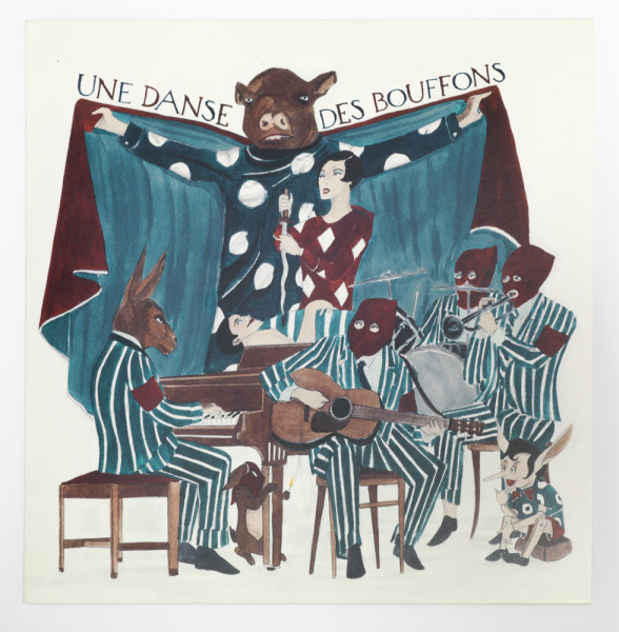Marcel Dzama “Une Danse des Bouffons (A Jester’s Dance)”
David Zwirner 19th Street

This event has ended.
David Zwirner presents an exhibition of recent and new work by Marcel Dzama. The exhibition will mark the United States debut of the artist’s latest film Une danse des bouffons (or A jester’s dance), which will be shown alongside related two- and three-dimensional work.
Described as a “Dadaist love story,” Une danse des bouffons (or A jester’s dance) is the artist’s fictionalized account of the ill-fated, romantic affair between Marcel Duchamp and Brazilian sculptor Maria Martins (who served as the model for Duchamp’s last major artwork Étant donnés). In Dzama’s film, using a recreation of Étant donnés, a mythological trickster awakens Maria Martins (played by Kim Gordon and Hannelore Knuts) from the sculpture. Finding Duchamp held captive and forced to blindly recite chess moves, Martins enters into the unknown game in hopes of saving her love. The role of the trickster was partly inspired by the Nigerian mythological god Edshu, recognizable by his hat that was colored red on one side and blue on the other, provoking confusion and argument amongst members of a community who would disagree on the color he was wearing. His mischief, while appearing to have a destructive effect, could also be perceived as allowing people to see that more than one perspective or answer exists.
The corresponding colors of red and blue will be thematically reflected within the space at David Zwirner, with works distributed between two galleries, each showcasing compositions predominated by warm or cool hues. Previously shown as a 35-minute loop in black and white that alternates between Gordon and Knuts in the role of Maria Martins, Une danse des bouffons (or A jester’s dance) will be installed in a new configuration for the exhibition. Here, each gallery will project one version with either a red or blue color filter, thus adding a new, dynamic dimension to the work.
With recurring themes of good versus evil, death and rebirth, love and lost love, multiple identities and doppelgängers, false prophets, the corruption of power, and tensions between reality and fiction, Une danse des bouffons (or A jester’s dance) draws from a diverse range of art-historical references. The Minotaur-like figure of The Dancing Golden Calf was inspired by Francis Picabia’s painting Adoration of the Calf from the early 1940s, which was itself based on a 1936 photograph by Erwin Blumenfeld titled Dictator. References to Francisco Goya’s late eighteenth century print They’ve Already Got a Seat (from the Los Caprichos series) appear through choices in costuming, notably in the upside-down chair affixed directly to Martins’s head, and Joseph Beuys is evoked through the props of a felt blanket, wooden cane, and taxidermied animal. Some of the characters’ masks bear resemblance to Oskar Schlemmer’s theatrical costumes from his early modern dances, while its kaleidoscopic effects and stage production appear reminiscent of Busby Berkeley’s Hollywood musical motion pictures. Viewing appropriation as a form of collaboration, Dzama incorporates his sources for imagery, narrative, and subject matter seamlessly, creating an aesthetic language that is at once universal and uniquely personal.
Media
Schedule
from September 09, 2014 to October 25, 2014
Opening Reception on 2014-09-09 from 18:00 to 20:00